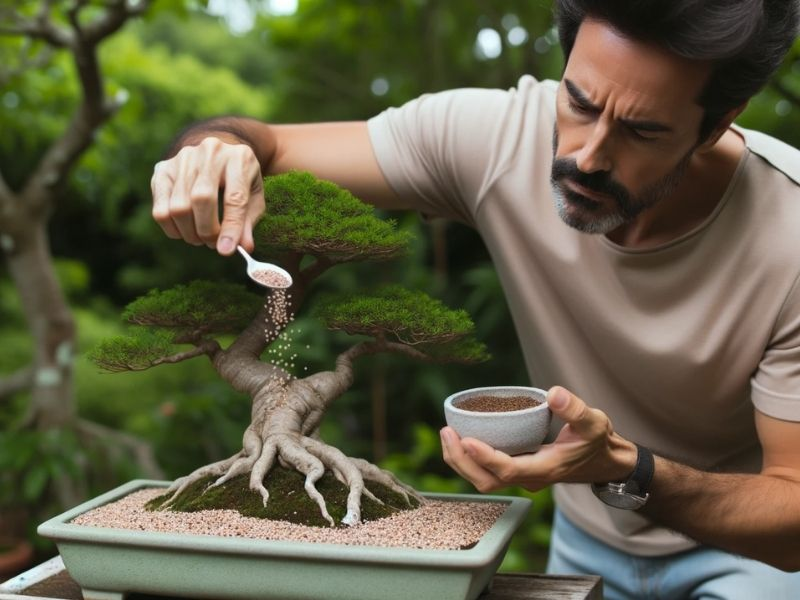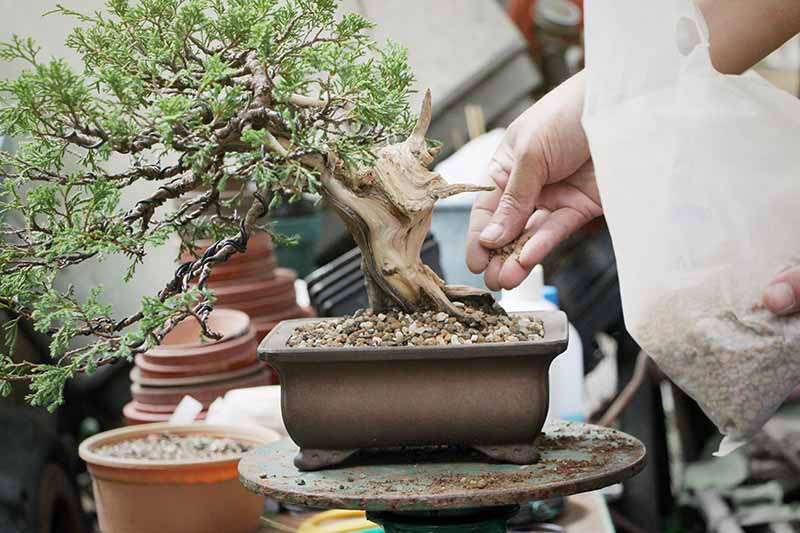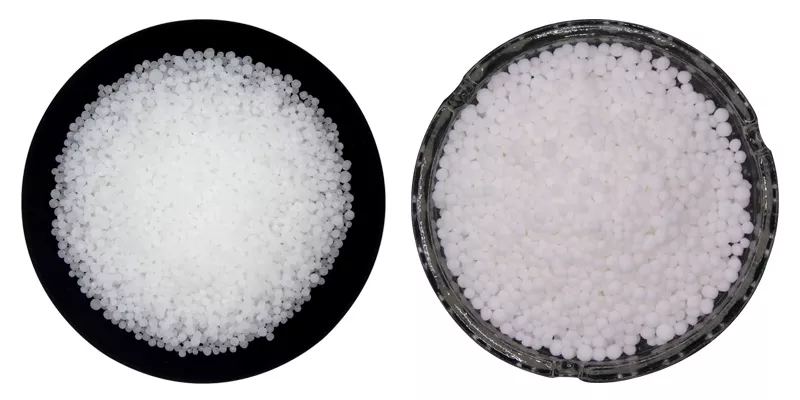Introduction to Organic Bonsai Fertilizers
The creation of such tiny wonders requires meticulous care, years of patient cultivation, and, most of all, proper nutrition. For long, lustrous life and invigorating vigour, bonsai owners need to find the best organic bonsai fertilizer. Sure, synthetic chemical supplementation keeps bonsai nourished and helps them to live and grow, but organic fertilizer solutions are more ideal because they match the natural developmental processes of bonsai trees much more completely.
Natural products are stressed by bonsai care experts. Linda Chalker-Scott, Ph.D., horticulturist and associate professor, Washington State University, suggests that ‘organic bonsai feed can reduce [soil] compaction and add essential nutrients, improving soil structure and health to create a more stable growth environment’. So the reason why the nature ofonsai cultivation becomes clear.
But there’s more to choose between than just growth, as well. While synthetics apply nutrients quickly and might have quick positive effects, they can also lead to an electrolyte salt build-up within the soil and often do harm to some of the beneficial microscopic creatures that help make healthy soil. Organics, by comparison, apply nutrients more slowly and at the same rate that a bonsai tree grows slowly yet organically that’s their namesake. Not only do those slower releases fit their slow-going growth habits, but they also help support a diverse and thriving soil ecosystem that’s essential for organic matter breakdown, expressing new life, and nutrient cycling.
Key Ingredients in Organic Bonsai Fertilizers
For the person who wants to care for a bonsai, it’s an advantageous thing to know what exactly goes into that organic bonsai fertilizer. The good thing is that the composition of organic bonsai fertilizer includes a lot of peaty materials that decompose slowly in nature, releasing nutrients gradually and thus giving the bonsai its natural feeding environment. In this brief article, we shall examine some of the most common natural materials used in these fertilizers and the kind of benefit it gives to bonsai health.
A key ingredient in most organic fertilizers is bone meal. It provides phosphorus, which supports robust root structures, which is important in a tree that has been pruned to be smaller than its normal, wild self, and will therefore rely on its root system. Bone meal also includes calcium, which strengthens cell walls and therefore makes for better growth.
Another is blood meal, a nitrogen-rich organic powder that encourages strong green growth and is especially useful in the early stages of shoot development: ‘Nitrogen is a lot about leaf and stems, but using more nitrogen fertilizers is always not good,’ says the Japanese bonsai master Dr Haruto Tanaka. ‘At a high rate it always makes a gashiki [leggy] tree. Bonsai have to have thick, hard middle, not too much leaf and not too long leaves.
Fish emulsion is also an effective fertilizer thanks to its balanced nutrient profile and fast-delivery qualities. Because fish emulsion is an all-in-one fertilizer, it’s also a good source of the trace elements that trees need for their overall health and vitality, in addition to nitrogen and potassium. Especially for bonsai trees displayed in a fashion that emphasises perfect miniaturisation and intricate landscaping, fish emulsion is a common fertilizer that helps to develop rich colour and density in leafy plants.
A popular ingredient, seaweed extract, is a source of micronutrients and growth hormones to promote the development of useful roots while improving tolerance to stress. In line with organic gardening philosophies, the use of organic bonsai fertilizer encourages the health of the bonsai. With the added benefit of root development and stress tolerance, the bonsai develops into a strong tree that is able to endure modest climatic changes and survive in restricted soil volumes.
Bonsai trees also tend to provide these benefits when grown organically, as each of these ingredients brings its own special benefit to bonsai health. Organic bonsai fertilizer thus offers a singularly holistic approach to promoting and maintaining the delicate stability that bonsai require to thrive.

Choosing the Right Fertilizer for Your Bonsai
It is important to carefully choose the right bonsai fertilizer according to the kind of bonsai you have. Different bonsai have different nutritional requirements, which change depending on the season or the development stage of the bonsai tree.
Each bonsai species needs different nutrient balances as well. For example, flowering trees need more phosphorus to promote blooms, while foliage species tend to thrive on more nitrogen to promote a lush, green mass of leaves. Know the specifics of your bonsai’s species; this is how they will want you to feed them. ‘When it comes to bonsai, doing research about your tree’s species is every bit as critical as learning to prune,’ says Michael Lee, a world-renowned Irish bonsai master.
In order to control the fertilizer feed, the season must be taken into consideration. As you would imagine, your bonsai will need more frequent feeding during the growing season, which is during spring and summer, to promote all that extra growth, but with the advent of autumn and winter, the tree is entering dormancy, when the nutrient requirements of your bonsai are reduced significantly. Overfeeding prior, during and after dormancy puts your tree at risk of nutrient overload.
Spring is the season for regular feeding with a well-balanced organic bonsai fertilizer that can be applied to give bonsai a strong start to the growth season. In late fall, a weaker, low-nitrogen fertilizer can be used as the bonsai prepares for winter, without fomenting new growth that could be damaged by the cold.
With all this in mind, it’s possible to select a specific type of organic bonsai fertilizer that will help your bonsai species flourish according to the season, enhancing growth in spring and slowing it down in winter, for instance. The overall outcome is one that encourages your bonsai to prosper and thrive, while looking great at the same time.
How to Apply Organic Fertilizer to Bonsai
Proper fertilisation of organic bonsai fertilizer might be as important as the type of fertilizer usage, as different from the typical measure and scatter methods we adopted for outdoor plants, cultivating bonsais necessitates a responsible management of fertilizer application due to bonsai trees’ shorter roots system growing in a smaller volume of soil, which may lead to toxicity from excessive amounts of nutrients, causing damage to the plants.
Step-by-Step Guide on the Application Process
Fertilizer Measure (Apply once a month from spring to late autumn, spacing out the applications by a period of weeks): Read the fertilizer packaging for the advised amount. Use a teaspoon, soup spoon or large scoop to measure out the needed amount. This will be enough for a larger bonsai pot.
Spread it around: Place an even layer of fertilizer directly on the surface area of soil around the tree, keeping it five to eight inches away from the tree trunk to avoid burns. This ensures access for the roots that are spread out around the pot.
Water: After applying the fertilizer, thoroughly water your bonsai. This will flow the fertilizer through your soil and begin to dissolve the fertilizer, spreading the nutrients out throughout your soil and disallowing nutrient pockets around your root zones that can damage roots.
Repeat if Applicable: Repeat this process according to the season that your bonsai is in. Usually, it’s helpful to fertilize every four to six weeks during growing seasons.
Tips for Frequency and Quantity of Fertilizer Application
Watch the Growth Response and Health: Check to see how your bonsai responds to fertilisation. Know that those are usually the signs of good health, like new growth, strong development, and leaves turning nicely green or pale green and shiny. Change the amount and frequency of your fertilizer after this watching stage.
Seasonal Adjustments: Apply fertilizer more frequently during the growing season (spring to early fall) and less frequently during the dormant season (late fall to winter).
Don’t over-fertilize: This can lead to salts accumulating in the soil, which can dehydrate the root system. If symptoms including stunted growth or yellowed leaves appear – perhaps because you have over-fertilized – reduce the amount of fertilizer you give to your plant, either in concentration or dose.
Do not over-water: Never over-water your plants, as this will lead your roots to drown, killing the plant.
‘It’s about constant observation and, where necessary, graceless course correction: you have to rely on the tree’s reaction to what you do,’ says Elizabeth Mott PhD, a scientist specializing in plants. ‘No two trees are identical, and their nutrient needs fluctuate as the tree grows, and in different environments – for instance, when the trees are in or outdoors, or indoors near or away from a window.’
If you follow these directions for applying organic bonsai fertilizer, your bonsai tree will get the nutrients that it needs, and you will avoid transplant shock and nutrient-induced stress, maintaining the tree’s health and enhancing its beauty.

Common Mistakes in Fertilizing Bonsai and How to Avoid Them
Working with bonsai presents a much greater challenge when it comes to fertilizing because the trees are confined and nutrition can be much harder to come by. By avoiding common mistakes, bonsai enthusiasts can lessen the risk of harming their trees and promote a more beautiful composition.
Over-fertilizing and Under-fertilizing: Signs and Solutions
Over-fertilizing: This is a common problem, and one that those new to bonsai care often fall prey to, mistakenly thinking that more fertilizer means faster growth. Vegetation affected by over-fertilization with growth being spindly and weak. Leaf burn, which shows itself by the tips of the leaves turning brown or yellow, and a white crust of mineral salts on the surface of the soil are the typical warning signs. To correct this, leach the soil by running water through the pot for a few minutes and allowing the loose material to thoroughly drain. Reduce the frequency and concentration of future fertilizer applications.
Under-fertilizing: In contrast, too little nourishment can inhibit the growth of a bonsai and result in pale, thin leaves. If a bonsai seems unwilling to thrive and isn’t producing new growth, it might be in need of more nutrients. Increase the frequency of fertilizing gradually, watching how the bonsai responds, and then adjust accordingly.
Ensuring Proper Soil Absorption of Organic Nutrients
The organic bonsai fertilizer will be absorbed by the soil, the soil by the plants, the plants by you. Proper nutrient absorption means maximizing that effect. There’re some simple things we can do to improve uptake.
Aerate the Soil: Once a year or so, use a small tool to loosen the top inch or so – this will help air and water get further into the soil and your plants’ roots absorb nutrients more effectively.
Consistent Watering: One of the key functions of water is to leach nutrients from fertilizer into the soil, so it is a good idea to water your bonsai well before and after fertilizer, to help the nutrients be absorbed into the soil.
Check the pH of the Soil: The pH (potential of hydrogen) of the soil can influence the availability of nutrients. Most bonsai trees thrive in slightly acidic to near neutral soils (pH 6.0-7.5). If you have a pH meter available, check the pH of your potting soil. Soil is generally categorized as slightly acidic, acidic, neutral, basic, or alkaline. The rates of nutrient uptake by plants change with the soil pH. One of our bonsai, an elegant bald cypress, died because the soil was too alkaline.
In contrast, Dr. John Kennworthy, another bonsai expert, highlights the necessity of a balanced nutrient supply: ‘Fertilizer is needed not just in quantity but balance. You need to monitor it, assess your bonsai’s response and adapt.’
By avoiding these pitfalls, and by ensuring that levels are moderate enough for us to respond to the plant in a timely way, rather than imposing missile-like treatments on innocent conifers, bonsai can be kept fertilized without any nutrient stresses coming into play.
The Impact of Organic Fertilizers on Bonsai Growth and Health
Eventually, this would result to a bonsai tree that is full not just of organic fertilizers but of all that they entail: skilled and artful formative pruning, varietal adaptability, immunity against fungal growth, and an organic inclination to resist threats. In short, organic bonsai fertilizers nurture and fortify bonsai trees to be vibrant and healthy for a long duration. Organic fertilizer brings to a tree more than just lushness.
Organic fertilizers are produced from slow-release sources such as natural ingredients. These decompose over weeks, months and, in some cases, years. In doing so, they mimic the natural nutrient uptake of bonsai trees growing in the wild. Here, bonsai trees don’t help themselves by absorbing nutrients that have just been dumped into the soil. Instead, they take up nutrients from organic matter that has been slowly broken down by organisms living in the natural forest. This slow release reinforces a natural process, reducing the risk of nutrient burn, where such an overdose leads to the death of plants.
Further, organic fertilizers amend the soil structure and improve its water and nutrient-retention ability. Gradually, a healthier root system develops. And a healthier root system is the foundation of a healthy, stable bonsai. The better soil also supports an environment with beneficial microorganisms, supporting healthy nutrient absorption.
For example, a bonsai cultivator in the state of Oregon, USA, replaced synthetic fertilizers with organic fertilizers and, over her collection of Maple bonsai, while observing improved colour and velveteen texture of the leaves over a two-year period, also noticed around a 30 per cent reduction in leaf scorching during periods of high temperatures that would repeatedly occur with synthetic fertilizers.
Even these examples highlight the role that organic bonsai fertilizer plays in helping to fuel vitality and beauty that allows bonsai to flourish – sometimes even for centuries. In sum, by going organic, bonsai ‘parents’ will do their ‘children’ a huge favour. And, if the caretaker is lucky, the bonsai will live a long, prosperous, and fetching life.
Conclusion: Embracing Organic Practices for Bonsai Care
Finally, this movement away from synthetic fertilizers and towards the use of organic fertilizer is not a fad but a basic principle of climate-ready bonsai and that’s why I’ve published this guide. It is fair to say that the evidence shows that using organic fertilizers instead of synthetic ones brings many benefits to the bonsai culture process. When we consider nature and the way plants really grow, using natural nutrients slowly released over a period of time makes perfect sense.
Organic fertilizers improve bonsai in many ways that build towards the kind of sustainable growth and beauty that we think of as ‘bonsai’. They provide natural nourishment and structure to the soil, as well as a well-functioning ecosystem of microorganisms that will support the tree to grow strong roots and resist diseases. They provide natural nourishment slowly enough that bonsai trees are not shocked by a sudden surge of chemicals, which can be harmful to their small systems.
Organic fertilisation offers bonsai practitioners a chance to extend their practice by immersing themselves in the wholeness of the natural lifecycle management By observing the responses of their trees to various organic resources, students can become gradually better at intuitively adapting the fertilisation schedule to meet the changing needs of their miniaturised trees.
In fact, if the case studies are any indication, the outcome of using organic fertilizers should be visibly impressive and the labour involved in effecting this transition is certainly worth it. In choosing to use organic methods, the bonsai carer not only maintains the tree’s health and beauty, but also furthers a more ecological form of horticultural practice.
In the end, the learning journey towards applying the right bonsai fertilizer enhances both a beginner and master bonsai practitioner’s journey towards creating resplendent, dense and green bonsai landscapes.
Here are some references on organic bonsai fertilizers :
- Bonsai Organic Fertilizer: Pros, Cons, and How-Tos – This article provides insights into using canola seed or soybean extracts as ingredients for bonsai fertilizer, emphasizing their proven benefits and suitable NPK ratios. It includes a step-by-step guide to making your own bonsai oil cake fertilizer at home.
- 5 Essential Bonsai Fertilizers for Healthy Growth – This source discusses how to select the right fertilizer for your bonsai by matching the fertilizer to your specific bonsai species and considering the N-P-K numbers critical for growth. It also offers guidance on when and how to fertilize bonsai trees effectively.
- Green Dream™ Original – 100% Organic Fertiliser – Promoted as the UK’s most popular bonsai fertilizer, Green Dream™ Original is highlighted for its convenience and effectiveness in nourishing bonsai trees throughout the growing season. It is organic and environmentally friendly.
- Biogold Original Organic Bonsai Tree Fertiliser – Known for its triangular pellets that release nutrients slowly, Biogold Original is a top choice for bonsai care, providing a balanced mix of nutrients. It’s particularly noted for being organic and ideal for home gardens.







